Progress of artillery during the Crimean War
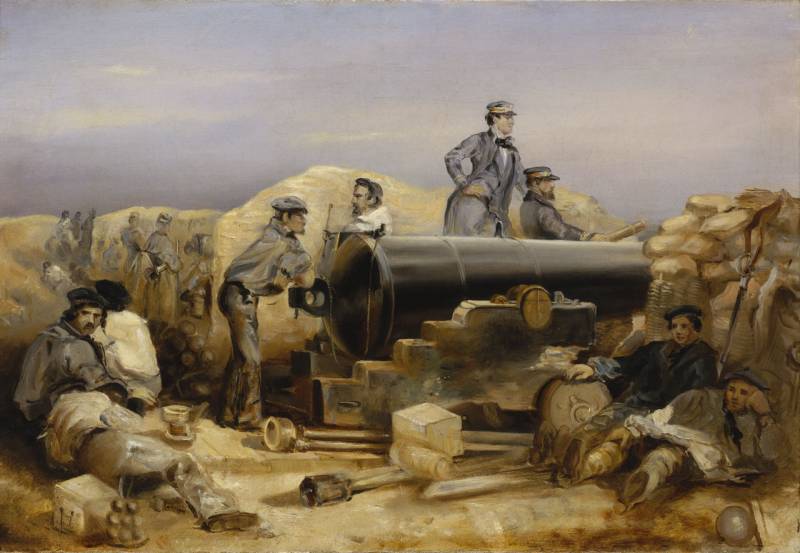
It is traditionally believed that the development of small arms played a major role in the Crimean War weapons, thanks to which the allies won it. However, the progress of all parties to the conflict in artillery, which had a much more decisive role than small arms, floats past readers. The artillery in Crimea confirmed that it is the “god of war” and the “last argument of kings,” since all sides of the conflict suffered the main combat losses precisely because of the actions of cannons, and not rifles.
prehistory
Actually, progress in artillery began earlier, with developments and understanding of the Napoleonic Wars. In 1822, French Army Colonel Henri-Joseph Pecsan proposed creating a howitzer cannon that could fire explosive shells with cocking along a flat trajectory. As Peksan himself wrote, he “I wanted to create a carronade, but one that would fire with the range and accuracy of a conventional cannon”.
The fact is that on the French ships of the Napoleonic era there were similar carronades (howitzers), which were equipped with explosive shells, but fired along a surface trajectory, Henri-Joseph developed guns and a type of charge that allowed these guns to fire along a flat trajectory.
In 1824, new guns were tested on a target ship, the disabled French 80-gun Pacificateur; due to a delay in the fuse, the shell first broke through the side of the ship and then exploded inside. Some of the bombs, hitting the barkhout area, got stuck in the casing and, when exploding, broke out entire sections of the hull.
In general, the weapon has proven its effectiveness.
The first 50 Peksan guns entered the fleet in 1827, but they were an experimental batch, they were tested for a long time, painfully, and only in 1841 they were put into service - it was then that the industry was able to master the mass production of such guns and hollow cores.
In 1845, bombing guns similar to the French ones were adopted by the United States. In 1847, Britain created and adopted its famous 68-pounder guns.
In Russia, experiments with bomb guns have been carried out since 1833, and a universal 3-pound gun for fleet entered service in 1839 - even earlier than in France.
Well, in 1849 thunder struck.
On April 5, 1849, in Eckernfjord, the Danish 84-gun battleship Christian VIII and the frigate Gefion, plus several steamships, were completely defeated by a Schleswig 10-gun battery armed with six 18-pounder, two 24-pounder and two 84-pounder bomb guns. Two bomb cannons gave Christian VIII three hits, but the main gravediggers of the battleship were the good old hardened cannonballs, because of which a fire started on the Dane, and after holding out under fire for several hours, Christian VIII raised the white flag.
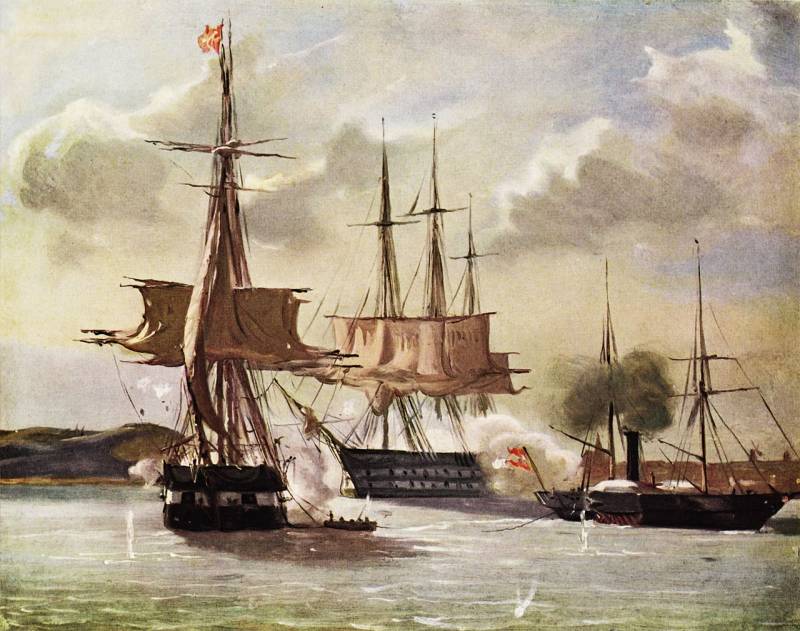
Battle of Eckernfjord.
What happened?
The Danish ships, possessing 132 guns, fired 6 shots at the enemy. The result is that the separatists had 000 killed and 4 wounded, 18 gun was knocked off its carriage, and even the field guns were not damaged.
Two batteries (4 and 6 guns) fired 450 shots at the enemy. The result is that 2 ships were actually destroyed, the Danes lost 134 people killed, 38 wounded and 936 prisoners.
In general, before the Crimean War, admirals and fleet captains began to experience a real “close range” disease; they were simply afraid to bring ships to lethal distance to fight coastal batteries, so as not to repeat the fate of the Danish ships.
The first bombing of Sevastopol
In March 1854, the Crimean War began, in September the Allies landed in Crimea, and on October 5 (17) the first bombardment of Sevastopol was planned, which the Allies planned to take in a swoop.
At the beginning of September 1854, 533 guns were concentrated in various forts and fortifications in Sevastopol.
Of them:
26 – 3-pound fortress cannons;
65 – 36 pound;
20 – 30 pound;
178 – 24 pound;
19 – 18 pound;
4 – 12 pound;
15 – 1-pound unicorns;
15 – half-pound unicorns;
26 – 5-pound mortars.
In addition, the Russians could remove from the ships:
10 – 2-pound guns;
20 – 1-pound unicorns;
141 – 68-pounder gun;
736 – 36-pounder guns;
202 – 20 pound;
30 – 18...12 pounds.
As of mid-October, the Allies had only 127 high-power ground guns and... a fleet. The confrontation between the united allied fleet and the Sevastopol batteries began at 7:00, when 5 frigates opened fire on the Konstantinovskaya battery, then battleships gradually joined the battle.
During the battle, one unpleasant feature for the allies was discovered - they could fire more or less safely for themselves only from a distance of 1–100 yards.
Thus, HMS Albion, which closed to within 700 yards of the Russians, simply fell out of the battle at 15:40, listing to starboard, and hastily headed for Istanbul.
HMS Trafalgar at 16:10 caught four red-hot cannonballs from a distance of 800 yards and hastily withdrew from the battle.
HMS Agamemnon, at a range of 900 yards, was hit three times below the waterline and nearly capsized.
HMS Rodney lost control and ran aground, no doubt she would have been shot if the clouds of gunpowder smoke had not enveloped (and hidden) her.
The French battleship Charlemagne was hit by a Russian bomb from a 800-pound cannon from 3 yards, breaking through all the decks and exploding next to the engine room. The ship lost all its masts and bowsprit, received only 93 hits to the hull, and could barely stay afloat.
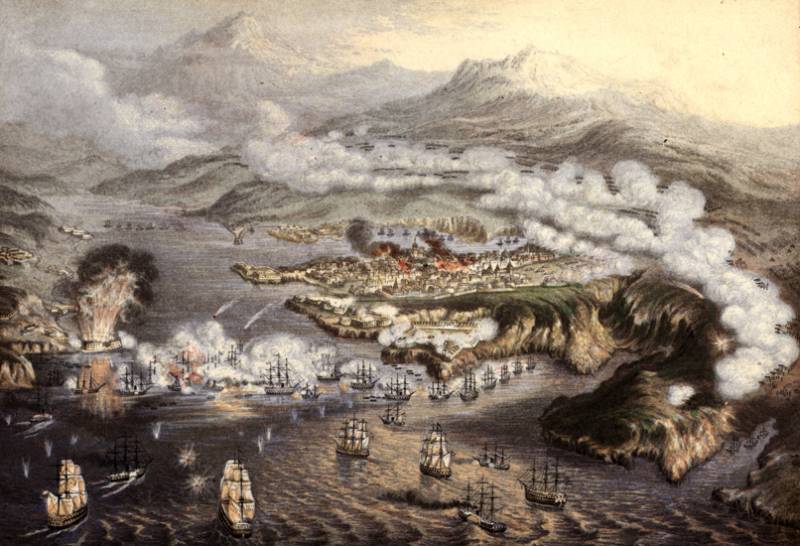
Bombing of Sevastopol on October 17, 1854.
Another French ship, Paris, received 800 hits at a distance of 1–000 yards and hastily left the battle.
Characterizing the state of the French squadron after the battle, one of the commanders of the French ships said:
You can continue endlessly. The Allied fleet lost 520 men in the battle. Russian losses in the batteries were 138 people.
Captain Agamemnon spoke excellently about the state of the Sevastopol forts on October 19, 1854:
The actual damage was only on the ledges under the embrasures. And these gouges in the walls under the embrasures could not even be noticed, since a few inches of stone knocked out have little effect on the defense of the fort, the walls of which are fourteen, and in some parts eighteen feet thick.”
After this battle, allied ships were officially prohibited from approaching the fortresses closer than 750 yards, and shelling was limited to only 1–000 yards. But how? And with what?
Lancaster guns
And at the end of 1854, the Artillery Committee of England urgently issued orders to companies for guns that would fire "up to 6 yards". It is clear that the idea was simple - to fire at the enemy from distances that he cannot reach.

"Diamond" battery from Lancaster guns during the shelling of Sevastopol.
At that time, there were several proposals on the committee’s table from major gunsmiths, in particular from Armstrong, but, apparently, Their Lordships simply poked at one of the projects with their eyes closed, and so the 68-pound Lancaster guns with oval chamber and 1,25 turn thread.
It was officially believed that their firing range was indeed 6 yards, but... in 500, after the Crimean War, shooting experiments were carried out and it turned out that an 1864-pound cannonball with a charge of 85 pounds of gunpowder gives a range of only 12 yards, but in this case the probability of hitting the target (which was a decommissioned corvette) is 4%.
Roughly speaking, at such a range the Lancaster guns could only hit a “city” type target. That is, if there had been a squadron against a squadron in the Crimean battles, then, most likely, the Lancaster guns would not have stood out in any way. But the British were lucky - in the Black Sea the Russians sank their fleet, in the Baltic the Russian fleet refused to fight for the sea, so the allies now had cities as their goals.
However, even the Lancastrian guns fired at a range of 3–000 yards, but when bombarding Sveaborg, several Russian guns were able to respond and even sink one and damage two allied gunboats.
Russian response
So, if in 1854 the battle distance was 800-1 yards, then in 000 it tripled - to 1855 yards. And the Russians understood that they needed to have some kind of artillery systems that could counter the allies in the changed situation.
In the winter of 1855–1856, Staff Captain Nikolai Vladimirovich Maievsky developed a new 60-pound cannon with a firing range of 3 meters (519 yards) at an elevation angle of 3 degrees and a gunpowder charge of 870 kg. Maievsky's slightly improved guns had a range of 18 meters (7,4 yards) with a cannonball and 4 meters (268 yards) with a bomb.
The first two experimental guns were manufactured in the spring of 1856 and placed on Kronstadt batteries, and their barrels withstood 1 shots without problems (the barrels of Lancaster guns wore out after 000 shots).
A little earlier, the 60-pounder Baumgarten gun with a maximum firing range of 2 meters (770 yards) was put into production; with an increased charge, this gun made it possible to fire at a distance of 3 meters (000 yards).
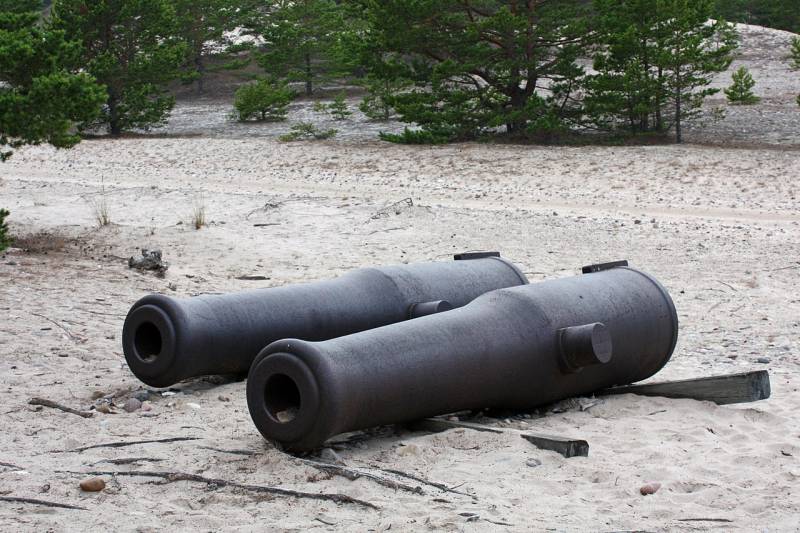
60-pounder Baumgarten gun.
In turn, the Allies began to think with all their might that in the next campaign the working range of artillery should be 4–000 yards. The parties also created 5- and 000-inch mortars over the winter, firing at distances of up to 12–13 yards.
The French took a different path - already in the spring of 1855, improved Congreve rockets with two stages were developed; first, one stage was tested, which completely burned out and burned through the partition of the other stage; as a result, the launch range increased from 2 yards to 200 yards. The first batch of these missiles was received by the French Admiral Penaud on August 3, 300, when the Allies abandoned further bombardment of Sveaborg. But the problems of conventional Congreve missiles remained in the new model - their range was highly dependent on the wind, and their accuracy was below any criticism.
In fact, if the Crimean War had continued, the working range of artillery would have become 4 yards, but in March 000 the Peace of Paris was concluded and the Crimean War ended.
Some conclusions
So, the firing range of guns during the Crimean War increased by 4–4,5 times. But without target designation systems and guidance at such distances, such shooting was essentially shooting at sparrows. Therefore, the question arose - are there any ways to reduce combat distances?
Back in 1843, the French were working on this issue, trying to protect ships not only with iron plating, but also... with rubber, sections filled with coal, layers of cast iron and iron, etc.
The French categorically did not want to fire at the forts at close range using wooden ships, because, as Napoleon III wrote, “You cannot risk a ship carrying 80 guns and 1 crew in confrontation with a piece of granite with several guns and a dozen gunners”. Actually, this is where the development of a coastal vessel for attacking forts grows, which would not be subject to major damage during this attack.
In 1854, the French laid down the first 10 armored batteries, but by April 1855 only three were ready, which were sent to the Black Sea. They worked well against Kinburn with his weak batteries, but even from the fire of Russian 24-pounder guns at a distance of 800 yards, rivets flew off the armor plates.
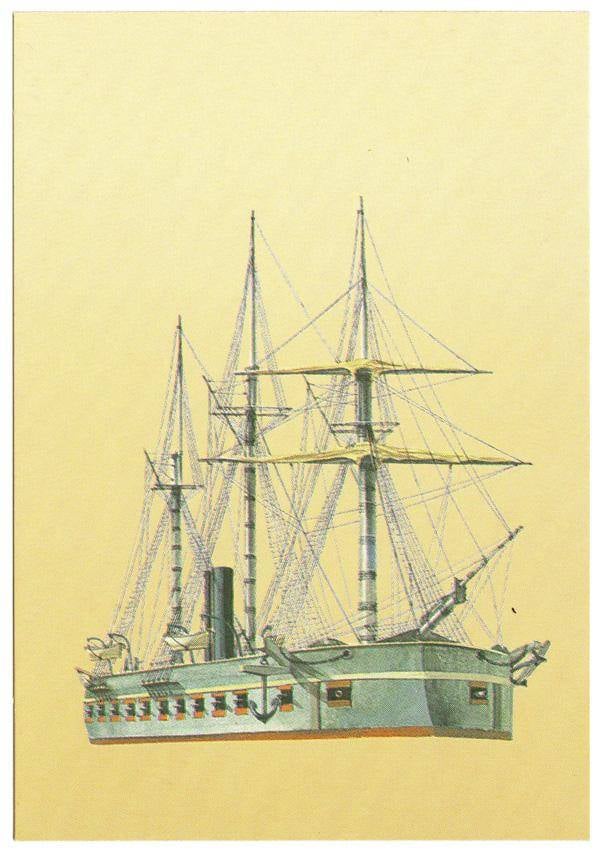
Self-propelled armored battery Dévastation.
In September 1856, after the war, at the insistence of the First Lord of the Admiralty, experiments were carried out which revealed that after two cannonballs (49 kg) hit from 68-pounder guns from 800 yards, the plates cracked, and at 400 yards the 68-pounder penetrated such through the slabs.
That is, having post-knowledge, we can say that armored batteries also did not become a panacea in the confrontation between the fleet and the coast.
Thus, despite the progress, defense has won so far.
References:
1. Chirikov N. S. “Emperor Nicholas I and the Fleet” - “Military True” magazine, September 2017.
2. Denisov A.P., Perechnev Yu.G. “Russian coastal artillery.” – M.: Voenizdat, 1956.
3. Rath, Andrew C. “The Global Dimensions of Britain and France's Crimean War Naval Campaigns against Russia, 1854–1856” – McGill University, Montreal, November 2011.
4. Lambert, Andrew D. “The Crimean War. British Grand Strategy Against Russia, 1853–1856" - Manchester, UK: Manchester University Press, 1991.
5. Lambert, Andrew D. “Looking for gunboats: British Naval operations in the Gulf of Bothnia, 1854–55” – King's College, London, June 2004.
6. Brown DK “Royal Navy in the Crimean war: technological advances” - “Colloque International Marine et Technique”, Paris, June, 1987.
Information